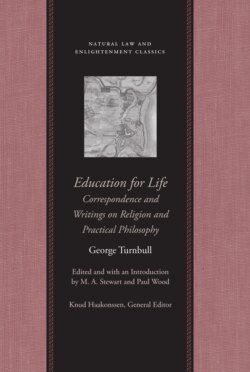Читать книгу Education for Life - George Turnbull - Страница 9
На сайте Литреса книга снята с продажи.
Оглавление[print edition page xxvii]
EDITORIAL PRINCIPLES
In editing printed material we have retained, as far as possible, the spelling, punctuation, and capitalization practices of the original compositors. We have silently corrected obvious typographical errors. Original pagination is indicated using angle brackets thus, <1>. Different works from different dates and different publishers show some variation in the conventions used to mark footnotes. We have not standardized the footnote markings themselves, although we have modernized the placement of Turnbull’s footnote markings. Where necessary we have also modernized the use of quotation marks. Editorial amplification interpolated in Turnbull’s footnotes is indicated by square brackets. The editors’ own annotations on the texts are supplied in a numerical sequence below the original author’s notes. Unless otherwise noted we have used the standard Loeb editions of Greek and Latin works, although in some instances M. A. Stewart and Michael Silverthorne have provided revised translations.
Turnbull’s biblical references cannot always be corroborated in known editions of the Bible. In our editorial annotations we have used the King James version as published in 1998 in the Oxford World’s Classics series. We have supplied references to the King James Bible for all of the biblical passages Turnbull quotes or alludes to, except where Turnbull’s own references correspond to the relevant passage in the King James version. Where there are multiple citations in Turnbull’s notes, our references follow the sequence of Turnbull’s citations. There are also instances where Turnbull’s biblical references make no sense and we have indicated such instances in our notes.
Where possible we have tried to refer the reader to Turnbull’s sources in reliable modern editions, but it has sometimes been necessary to draw attention to features of the editions that Turnbull himself cites. Many of the
[print edition page xxviii]
editions of the seventeenth- and eighteenth-century works to which Turnbull refers are readily available in either microfilm or digital form. Further information on a number of the British subjects identified in the editorial annotations can be found in the Oxford Dictionary of National Biography.
In editing manuscript material, we have again followed as far as possible the spelling, punctuation, and capitalization of the originals. Even though Turnbull retains archaic spellings that have long gone out of use (for example, “wiew” for “view”), we have made no attempt to modernize or standardize his spellings. Turnbull’s use of punctuation may seem erratic to a modern reader, but it is no more so than was common in his day. However, where his lack of punctuation creates significant ambiguity, we have clarified his sense by inserting the necessary punctuation enclosed in angle brackets thus, < >. Occasionally syllables and words have been duplicated and in these cases the duplication has been silently deleted. Where it has seemed essential to adjust erroneous or missing lettering to convey the intended sense the editorial revision is inclosed in angle brackets thus, < >. We have also indicated the pagination of Turnbull’s “The Religion of the State” using angle brackets thus, <3>. Contractions have been silently expanded. Characters in superscript have been printed on the line. In order to provide easily readable texts, we have not recorded authorial insertions or deletions. Instances of such revisions in the manuscript and letters transcribed below are relatively infrequent and of no consequence for the meaning or interpretation of Turnbull’s writings. Editorial notes to the manuscript and to the letters are provided in a numerical series of footnotes.
Our presentation of Turnbull’s letters is modelled on that of the published correspondences of Adam Smith and Thomas Reid. At the head of each letter we have provided information about the address (when given) and the source used for the text. We have stated the place of origin and date of writing in that sequence at the top right of each letter thus, “Edinburgh, 13 November 1718.” We have not standardized the places of origin given, but we have standardized the form of the date on which the letter was written. Where information relating to addressee, provenance, or date of a letter is conjectural, this is supplied in square brackets.
